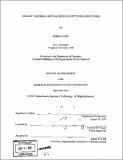| dc.contributor.advisor | Timothy M. Swager. | en_US |
| dc.contributor.author | Chen, Zhihua, Ph. D. Massachusetts Institute of Technology | en_US |
| dc.contributor.other | Massachusetts Institute of Technology. Dept. of Chemistry. | en_US |
| dc.date.accessioned | 2008-05-19T16:12:10Z | |
| dc.date.available | 2008-05-19T16:12:10Z | |
| dc.date.copyright | 2007 | en_US |
| dc.date.issued | 2007 | en_US |
| dc.identifier.uri | http://hdl.handle.net/1721.1/41722 | |
| dc.description | Thesis (Ph. D.)--Massachusetts Institute of Technology, Dept. of Chemistry, 2007. | en_US |
| dc.description | Includes bibliographical references. | en_US |
| dc.description.abstract | Chapter 1. The synthesis of a group of alkoxy-substituted para-acenequinones and their photophysical properties in solution and liquid crystal are reported. Polarized absorption and fluorescence measurements demonstrate that these acenequinones have excellent alignment with nematic LC hosts, indicating their potential as dichroic dyes for guest-host liquid crystal displays. In addition, the sensitivity of emission to the substitution allows the tuning of emission by functionalization of the acenequinone chromophore. Chapter 2. The synthesis of a series of fluorine- and alkyl/alkoxy-functionalized tetracenes using N-methyl-1,2,4,5-tetrafluoroisoindole as a synthetic building block is reported. The incorporation of fluorine functionalities was found to induce significant face-to-face molecular n-stacking in their crystal structures. Electrochemical behaviors and UV-vis absorbance spectroscopy results of these materials are also discussed. It was demonstrated that the substitution of alkyl/alkoxy groups on the main chain not only provided better solubility in common organic solvents, but also subtly tuned the crystal structures and electrochemical behaviors. Chapter 3. A self-polymerizable AB-type monomer for Diels-Alder (D-A) polymerization was prepared, and its polymerization was carried out in the melt phase and at high pressure in solution. The former method generated only low molecular weight polymer, but the latter one offered an efficient polymerization with increased molecular weight, due to the effect of high-pressure on reactions with a negative activation volume. A pyridinium p-toluenesulfonate catalyzed dehydration reaction of the D-A polymer led to a novel aromatic ladder polymer, poly(iptycene), which is soluble in common organic solvents and stable up to 350 oC. | en_US |
| dc.description.abstract | (cont.) The NMR and UV-vis spectra of these polymers match the spectra of their corresponding model compounds, and their synthesis is also reported. Chapter 4. Two diamino functionalized iptycene monomers were successfully synthesized via two synthetic routes: a direct nitration of triptycene followed by a reduction with hydrazine and D-A reaction between a benzo-fused 1,4-endoxide and 2,6-diaminoanthracene followed by a strong acid catalyzed dehydration. Their applications in the synthesis of novel triptycene-containing polyimides and polyureas were investigated and the resulting polymers were characterized by NMR, FT-IR, and UV-vis absorption spectroscopy. Chapter 5. Iptycene type quinoxaline and thienopyrazine monomers were successfully synthesized via a condensation between 10-dihydro-9,10-ethanoanthracene-11,12-dione and the corresponding diamines. Copolymers based on fluorene and these new iptycene monomers were prepared via Suzuki coupling reaction, and they exhibited good solubility in appropriate organic solvents. These copolymers are fluorescent both in solution and the solid state, emitting blue, greenish-blue, and red color, due to the electronic properties of the iptycene comonomers. The difference in their absorption and emission spectra was attributed to the donor-acceptor charge transfer interactions and/or polymer backbone conformation change induced by steric effects. Moreover, the spectroscopic data clearly demonstrated the insulating effect of iptycene units, which prevented the aggregation of the polymer chains and formation of excimers in the solid state. | en_US |
| dc.description.statementofresponsibility | by Zhihua Chen. | en_US |
| dc.format.extent | 2 v. (252 leaves) | en_US |
| dc.language.iso | eng | en_US |
| dc.publisher | Massachusetts Institute of Technology | en_US |
| dc.rights | M.I.T. theses are protected by
copyright. They may be viewed from this source for any purpose, but
reproduction or distribution in any format is prohibited without written
permission. See provided URL for inquiries about permission. | en_US |
| dc.rights.uri | http://dspace.mit.edu/handle/1721.1/7582 | en_US |
| dc.subject | Chemistry. | en_US |
| dc.title | Organic materials with acenoid and iptycene structures | en_US |
| dc.type | Thesis | en_US |
| dc.description.degree | Ph.D. | en_US |
| dc.contributor.department | Massachusetts Institute of Technology. Department of Chemistry | |
| dc.identifier.oclc | 224010925 | en_US |
